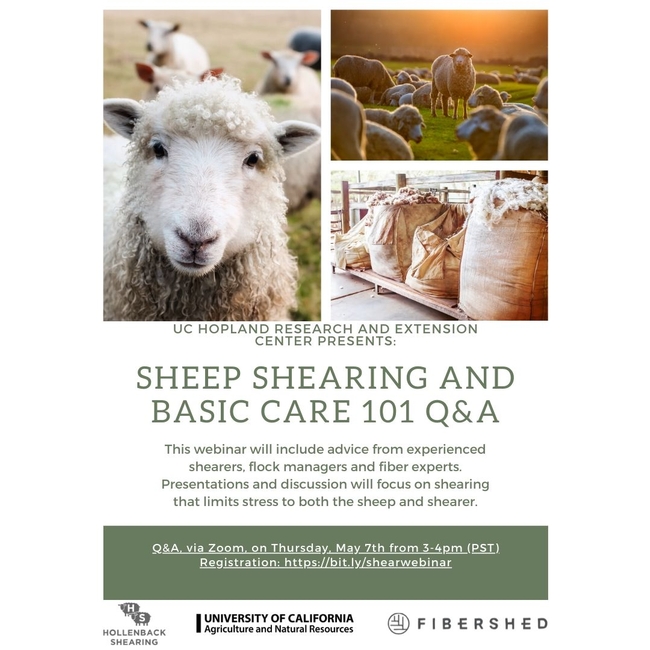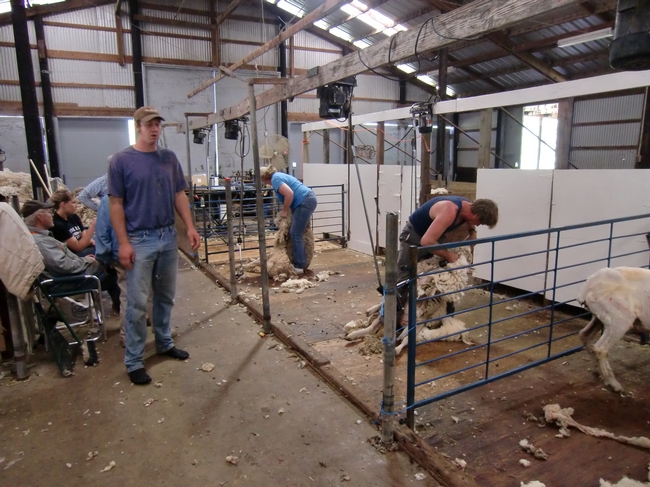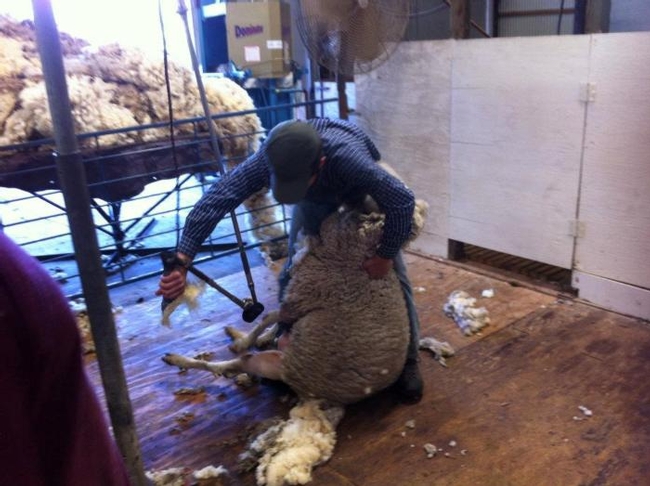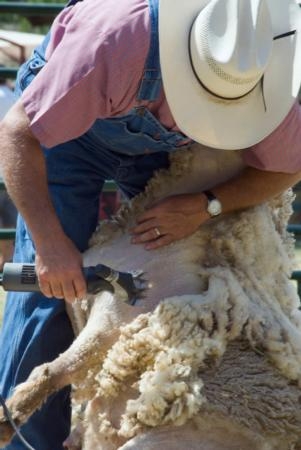Posts Tagged: Shearing
Webinar: Sheep shearing and basic care 101
The University of California Hopland Research and Extension Center (HREC) will offer a sheep shearing and basic care Q&A via Zoom from 3 to 4 p.m. May 7. The session will include advice from experienced shearers, flock managers and fiber experts.
Presentations and discussion will focus on shearing that limits stress to both the sheep and shearer. We also encourage your questions regarding sheep handling, husbandry, flock health, running a mobile shearing service, ethical shearing, grazing for fuel reduction and climate beneficial ranching practices. This webinar will take the place of the planned Sheep Shearing and Basic Care 101 immersive workshop planned at HREC in Spring 2020.
Participants in the webinar may also be interested in learning more about the class planned for 2021. Due to these unprecedented times, you do not have to have been registered for the Sheep Shearing 101 class to attend this Q&A session.
The session is free, but registration is required. Click here to register for the webinar and to share your questions.
Speakers:
Ruthie King
King is a shepherd focused on intensive rotational grazing for soil building, ecosystem restoration, fuel reduction and nutrient/water cycling. She raises Icelandic and Targhee sheep and sells meat, wool, and pelts through direct marketing. Services she offers include sheep shearing and contract grazing.
Alison Smith
Smith is the shepherd of the flock of over 200 sheep at the UC Hopland Research and Extension Center. She also supports research and extension at the site.
Trevor Hollenback
Owner/operator of Hollenback Shearing, Hollenback has been professionally trained and employed as a shearer in the United States, New Zealand, Australia, and Austria. His primary focus in shearing is limiting stress to both the sheep and shearer.
Rebecca Burgess
Burgess is the executive director of Fibershed, chair of the board for Carbon Cycle Institute, and the author of “Harvesting Color.” A vocationally trained weaver and natural dyer, she creates hands-on curricula that focus on restoration ecology and fiber systems. Burgess has built an extensive network of farmers and artisans in the Northern California Fibershed to pilot an innovative fiber systems model at the community scale.
UC sheep shearing school prepares students for gainful employment
“I tell my sheep shearing students, ‘You'll never be unemployed,'” said John Harper, UC Cooperative Extension livestock and natural resources advisor in Mendocino County. “And you'll never be poor.”
Shearers can earn $50 to $100 per hour, Harper said, and can start a business with a $3,000 investment in equipment.
“If they can learn how to shear sheep correctly, it's a great little business to get into,” Harper said.
The need for skilled sheep shearers in California and other parts of the nation has prompted the UC Hopland Research and Extension Center to host an annual sheep shearing school, where a diversity of students are introduced to a trade that allows them to work with their hands, out-of-doors, when and where they want.
Although sheep shearing is traditionally a male occupation, Harper said he encourages women to take the course.
“Women have a lower center of gravity. Strength is important, but so is hip rotation,” Harper said. “The sheep's skin is very loose and the blades are pretty powerful. The female students tend to be more cautious and we see fewer nicks.”
Beatrice Thomas, 41, is a typical student.
“I came to sheep shearing by way of dance and the arts,” Thomas said.
She left her Bay Area desk job about a year ago. “There wasn't a mind-body connection,” she said. “Forty hours at a desk, my body was aching.”
But sheep shearing was a completely different experience.
“This doesn't hurt the same way as sitting at a desk, because it feels vital. Every move is important. There's a dance. There's a rhythm. My whole spirit lit up,” Thomas said.
The 5,200-acre Hopland Research and Extension Center is home to a flock of about 1,000 sheep, which provide opportunities for scientists to study their role in land management. They also serve as a ready supply of animals for prospective new shearers to learn the craft.
“We teach students how to shear in a way that ensures the welfare of the sheep, produces a quality wool clip, and keeps the shearers safe,” Harper said. “We received a grant from the National Sheep Industry Improvement Association to purchase new shearing equipment. This allows the students to learn with brand new, state-of-the-art combs, cutters and hand pieces.”
The annual sheep shearing school at Hopland is the only intensive five-day course in the United States, said Hannah Bird, community educator at the research center.
“It brings people from all over the country and sometimes outside the country,” she said.
The week together helps build camaraderies amongst the newly trained sheep shearers. Hopland sheep shearing alums have created a Facebook group to stay in touch and refer jobs to one another. Several previous students are making a living a sheep shearing. One is Stephany Wilkes, a 2013 sheep shearing student who now runs her own sheep shearing business from San Francisco.
“People always ask me, ‘How can you run a sheep shearing business and live in the city?'” Wilkes said. “But there are actually a lot of sheep in the Bay Area, in Marin County, Solano and Yolo. I shear in Hayward and as far south as Gilroy. I go can go anywhere a car can.”
Lead instructor Gary Vorderbruggen said a key to sheep shearing success is a calm demeanor.
“Sheep don't need to be riled up. If you can be calm, and be safe, you will gain speed with experience,” Vorderbruggen said. “It's no different than a dance. It's like a square dance, except you're doing that square dance with an unwilling partner.”
Joining Harper and Vorderbruggen instructing the class in 2016 was Trevor Hollenback. He was first exposed to sheep shearing when visiting a friend's sheep farm in Austria.
“I realized this is a really skilled craft. It's amazing,” Hollenback said.
Hollenback quit his desk job and traveled to New Zealand for training, then returned to the Austrian farm for more practice. Back in the United States, Hollenback opened his own business and began shearing sheep in California and Arizona. He was tapped to be the instructor at Hopland because of his formal training in New Zealand.
“One of the most important things that the students can take away from this course is going to be sheep handling, how to move the sheep around, how to control the sheep on the board,” Hollenback said. “A lot of students came here with very little background in livestock. Footwork, positions, getting the pattern down – all the finer points in shearing – that comes with practice.”
The week-long sheep shearing school at Hopland will be held again in spring 2017. The class typically fills up within two hours of opening registration. Register interest on the UCCE Mendocino website to be notified when registration opens.
View scenes from the 2016 Sheep Shearing School at Hopland in the video below:
'Wild and wooly' sheep shearing class held at Hopland
Many sheep shearing students said the process was "the hardest thing they have ever done," reported Glenda Anderson in the Santa Rosa Press Democrat. The newspaper ran a lengthy feature and a photo gallery of the annual sheep shearing school held at the UC Hopland Research and Extension Center this week.
Reporter Justine Frederiksen of the Ukiah Daily Journal also reported on the sold-out sheep shearing and wool classing training at the 5,300-acre Mendocino County research center.
“And 60 percent of these people had never even touched a sheep before,” said John Harper, UCCE advisor and shearing school leader. Nearly all the students were women and included an artist from San Francisco, a retired fire chief, a UC Davis graduate student, and a woman who was learning to shear ahead of travels to New Zealand “because I think it will be a good skill to have for work, in case I want to stay for a couple of months.”
“One of the things new students have the most trouble with is what we call ‘tipping' the sheep, or flipping them over,” Harper said. He explained that, to get the sheep into the ideal starting position, you need to push its back legs down with one hand and tuck its head in with the other, twisting the animal into a sitting position with all four legs dangling.
UC Hopland REC sheep shearing students are part of a new wave of sheep shearers and wool enthusiasts industry officials hope will reverse decades of disinterest and decline. The shearing classes were booked well ahead of time, said Hannah Bird, a community educator at the research station. Many students are seeking a break from city life or jobs tying them to a desk.
Wrote reporter Glenda Anderson, shearing sheep is sweaty, back-straining work that earns just $2 to $5 per sheep. But an expert sheep shearer taking part in the program said sheep shearing for a living has its benefits.
“It's a lifestyle thing. I could work six months a year and travel around the world,” paying for the travel by working here and there, he said.
Software developer quits job to shear sheep
"This year, I was on a ranch almost every weekend from January through June," Wilke said. "I got pretty burnt out."
With skills honed in three five-day sessions of training at the UC Agriculture and Natural Resources facility in Hopland, she has found she can earn between $50 and $100 per hour shearing sheep.
John Harper, UC ANR Cooperative Extension advisor in Mendocino County, has hosted the sheep shearing school for 20 years and has 40 years experience with sheep shearing.
"It is the longest running shearing school in California and I believe it's currently the only one," Harper said.
The training school started with instructors imported from New Zealand. When the cost of travel became prohibitive, Harper brought in Mike McWilliams from Oregon. Later Gary Vorderbruggen, who trained under McWilliams, became the chief instructor.
The five-day course will be offered again in 2016 with classroom instruction, demonstrations and hands-on experience. Beginning and experienced shearers have the opportunity for one-on-one training. Class dates have not yet been decided. Registration information will be posted on the Sheep Shearing School webpage.
View a PDF version of the Sheep Magazine article by clicking the link below.
Sheep Magazine article
UC ANR workshop inspires economic development
UC Agriculture and Natural Resources (UC ANR) is helping get a new industry off the ground in Mendocino County, reported Justine Frederiksen in the Ukiah Daily Journal.
The UC Hopland Research and Extension Center, a UC ANR facility, hosts an annual Sheep Shearing School, thought to be the only one in California. The students take a five-day hands-on course to learn how to maintain a quality wool clip and minimize stress to the sheep.
"It's like learning to square dance," said instructor Gary Vorderbruggen. "Except you're learning to dance with an unwilling partner."
UC ANR Cooperative Extension natural resources advisor John Harper facilitates the school in Mendocino County.
"I always say, you'll never be unemployed if you learn how to shear," Harper said. "There's never enough shearers."
One local resident who attended Sheep Shearing School twice, Matthew Gilbert, was inspired to open a local wool processing enterprise.
"It's the perfect fit for this county, because it will provide jobs for this rural economy," Harper said.
Many wineries are using sheep to clip cover crops because the sheep can't get up on their hind legs like goats to reach the foliage. Even as more sheep are working local vineyards, "we're losing the infrastructure to support the (sheep) industry," Harper said.
Last week, the Ukiah Planning Commission unanimously approved permits for Gilbert to operate a wool mill and food truck on his property, said another article in the Ukiah Daily Journal. The food truck will help supplement the family's income for the first couple of years until the mill becomes established.
Further enhancing local interest in the Mendocino County sheep industry, the Hopland REC hosts a Barn to Yarn event from 10 a.m. to 2 p.m. May 23. Visitors will see shearing, spinning and weaving demonstrations and learn how to class wool and dye it using Kool-Aid. Admission is $5 per person, and children under 12 are free. The Hopland REC is at 4070 University Rd., Hopland. For more information, call Hannah Bird at (707) 744-1424, ext. 105.






